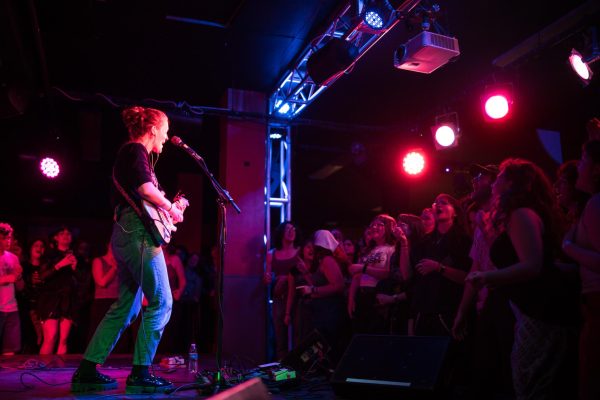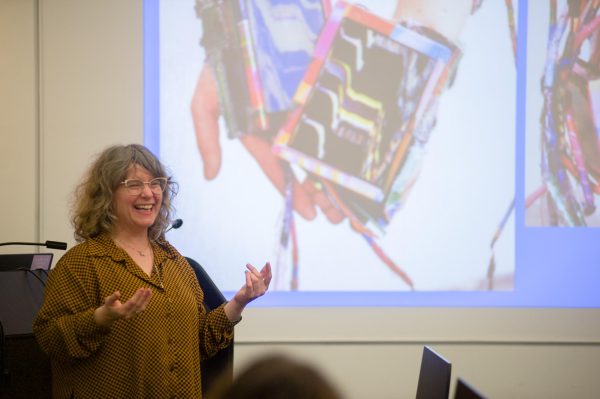Behind the Scenes: “Cosi Fan Tutte” Opens This Wednesday
Beginning Wednesday at 8 p.m., the Oberlin Opera Theater will continue to uphold a tradition that’s at least four decades old: producing Mozart’s Cosi Fan Tutte once every 10 years.
First performed in 1790, Cosi Fan Tutte is set in Naples and centered around a scheme between three military officers and a maid, Despina, to test the fidelity of two of the officers’ lovers. The eldest officer, Don Alfonso, bets against the younger Ferrando and Guglielmo that, by the end of the day, he will prove that their sweethearts, Dorabella and Fiordiligi, aren’t eternally loyal to them.
“It can be a harsh and bitter comedy,” said Costume Designer Chris Flaharty. “At the beginning of its life, it was taken as a very risqué and scandalous piece. The Victorians wouldn’t do it.”
Jonathon Field, the show’s director, explained that some of Mozart’s historical controversy stemmed from his challenge of social class conventions, which was also a theme in The Marriage of Figaro and Don Giovanni.
“What he did that is so unique is that he wrote some of the more beautiful arias for the servant class,” Field said.
Conservatory fourth-year Alexis Reed, who plays Fiordiligi in two of the performances, explained Mozart’s focus on the working class.
“He makes the working class smarter than the upper class in most of his pieces,” Reed said. “He makes fun of the upper class to bring them down off their pedestal and celebrates the cleverness the working class uses to their advantage. You’ll see that Despina thinks the girls are stupid and tricks them all the time.”
In this time period, Western European society was hypersensitized to any challenge to class hierarchy.
“The rights and equality of humanity was very much a discussed topic,” Field explained. “[You] have the French Revolution, which [is] turn[ing] everything upside down, and you’ve already had the American Revolution.”
Though Cosi may not have been a hit in the 19th century, it’s now so popular it’s considered a standard. Still, Flaharty says that the opera maintains its controversy.
“I think it’s more provocative and challenging to audiences now than it was in 1790,” he said. “You learned a little lesson, didn’t you, but now you can’t return back to the way it was. With our contemporary eyes, we see those differences. I’ve also heard comments about the cruelty of the men’s actions. But the women romanticize their lovers just as much as the men do. It’s about four callow young people … [coming] around to a sense of reality, like, ‘Wake up, we’re all humans here, we all make mistakes.’”
Though the performance has evolved since its debut, Oberlin’s production is set in the time period of its creation, featuring a finely-detailed, hand-painted set, mirrored floors, and nearly historically-accurate costuming.
“Because the construction was on the medium side, the painted details took more time,” said Joe Natt, the show’s technical director. “We started building this show at the beginning of December, painting it as we go along.”
Because of the size of some of the set’s components, the painters had to use a projector to keep the proportions accurate. Surprisingly, the painted detail is a more notable aspect than the mirrored floor — Natt has overseen three iterations of Cosi with this feature. Field explains that he’s continued to use the mirrored floor because of how well it works.
“I love it because it heightens the artificiality of the characters [and] their manners,” he said. “The glow from underneath makes the actors look like moving Dresden dolls.”
Accentuating this artificiality is the actor’s historical physicality, driven by both the feel and physical constraints of period dress.
“Sitting down when you have layers of skirts feels different,” Flaharty said “It should help the performer with that feeling of elegance and refinement that we’re hoping they achieve for the character. The corsetry … [won’t let] you bend over at the waist and pick up something. You find a different way to do it, and that’s how the women at the time would have done it.”
All of these design elements enhance the music and acting in the show.
“Pay attention to who sings together, because that means they’re in the same mind space,” Reed advises. “Mozart’s music reflects what the character is genuinely thinking and feeling.”
Cosi Fan Tutte plays Wednesday, March 11 through Sunday, March 15 in Hall Auditorium. Tickets are $8 for students and $10 for the general public.










